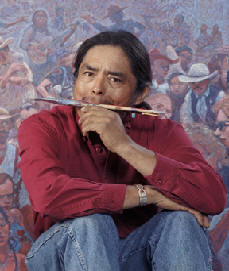As some of you may know by now, I was the featured artist at the Heard Museum a couple of weekends ago and therefore was not able to attend the third annual Viola Awards gala. I would like to congratulate all the recipients of the Viola awards. It truly is a blessing to be part of such a vibrant community of artists, to be part of a community that treasures you. All of you, especially the nominees that went home without awards, you are someone’s muse, someone’s nomination.
The Heard Museum held its 53rd annual Native Fair and Market the first weekend in March. I have been involved since the early 1990s. As an honored artist, I do have responsibilities, one being to serve as one of the judges during the best-of-show awards. On the Thursday night prior to the market, we spent five hours going through and selecting the outstanding pieces from all the entries. There are at least three judges in each category; we have paintings, drawings, prints and photographs. We have basketry, pottery, sculptures and carvings. We have jewelries of all sorts and subcategories. It was a strenuous undertaking to decide what held the artists’ best intent, what pieces deserved recognition and to defend your choice in this crowd of distinguished judges. Captivating pieces were everywhere and it was a task. Everything about a piece was scrutinized: the overall image, the representation of a culture and how cutting edge it was for me. I chose a photograph by a young up-and-coming artist which I deemed to have embodied all the qualities of a serious endeavor plus aesthetic achievement. I defended it successfully. There are the usual first, second and third places in each category. There are honorable mentions and judge’s awards so more artists can walk away with prizes. There were memorial awards embodying the spirits of past artists. I chose never to judge kids’ artwork because how can you? They are all true expressionists.
I no longer enter award shows in these venues. I do not need any more ribbons. I am fortunate to have been accepted early on and now possess a cooler full of colorful acknowledgements. Nothing more to prove as an artist outside of myself. But ribbons and such never was the reason. It is supposed to be the great motivator in continually challenging myself. It is a great “… you love me, oh my god, you love me …” moment in the words of the great effervescent Sally Field.
I stopped entering these shows some years back when a young man pleaded with me not to enter because he wanted a chance at the prize. I realized the truth in his words. I did not enter that year and he took home the coveted first place and the best of class. My ribbons moved inward as colorful as ever. I have been and always will be a firm believer that I have to paint for me; I am locked in a beautiful grapple/dance with my muse that allows me to remain what I am even if I had never received any awards for it. I satisfy my eyes before I release my works into the world. I know my story well.
Apart and with the great names in the world of art, I carry with me those that left an impression on me. Names such as Alan Houser, a great Apache sculptor, T.C. Cannon, a Kiowa/Caddo painter, Dan Namingha, a Hopi abstractionist, my own elder relatives, Harrison Begay, Andy Tsinijinnie and Narcisso Abeyta. There are names I echoed, like Jimmie Abeita, the Navajo realist, Quincy Tahoma and Bi’atiin Yaz. These are the Native artists that have stayed with me throughout my career. There are many peripheral image makers such as R.C. Gorman and Kevin Red Star and my older brother, Baje Whitethorne. These and many more innovators and translators of our world view as Native artists have sustained me. They granted me permission to explore those corridors of our oral and visual history. I try to do this without fear. This circle of ancient mystics and sacred clowns accepted me.
The morning after the award ceremony, a lone voice cries out, “What? Are the judges blind?!”

